Menus
- Duel of the super athletes
- These motorcycles represent the crown of creation
- Both motorcycles allow shifting lazy driving
- BMW developers have deliberately avoided using a balancer shaft
- Ratio comparable to that of Honda and Yamaha in the MotoGP World Championship
- BMW S 1000 RR factory-set with four preconfigured modes
- The ABS and combination brake system of the Yamaha YZF-R1 are constantly activated
- Technical specifications
- MOTORCYCLE test results
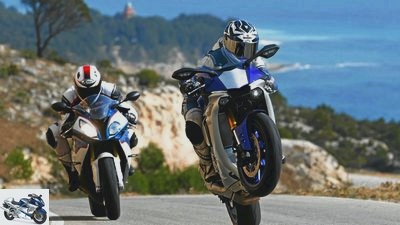
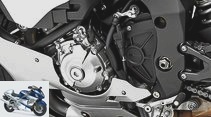
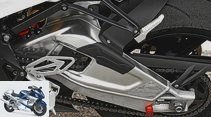
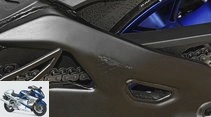
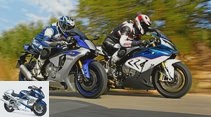
31 photos
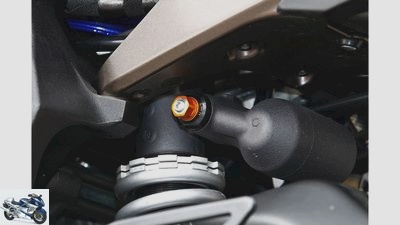
1/31
Yamaha YZF-R1.
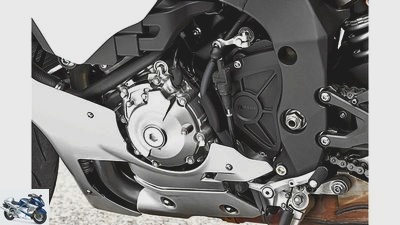
2/31
On both motorcycles, reversing the shift pattern is a minor matter …
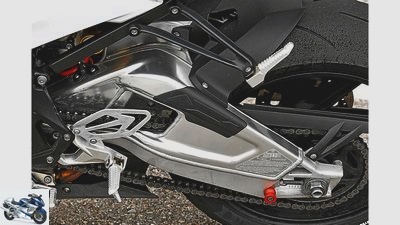
3/31
… this is kindly standard on the BMW S 1000 RR.
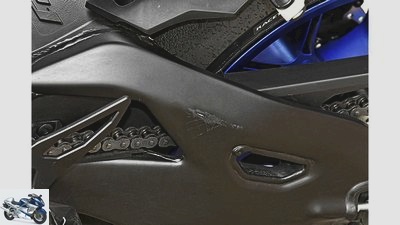
4/31
As shown in the top test (issue 8/2015), scratching the swingarm of the Yamaha YZF-R1 is inevitable without a protective cover, …
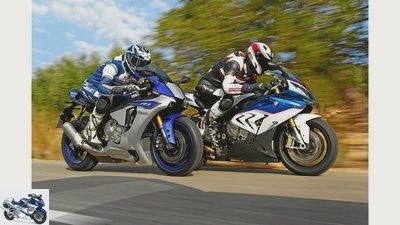
5/31
A symbolic photo: There’s Zug behind it.
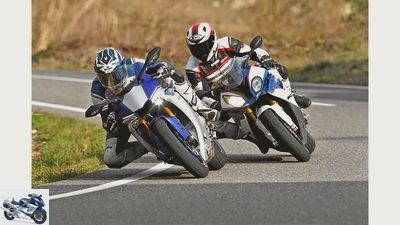
6/31
Many roads in the Spanish hinterland offer non-slip asphalt.
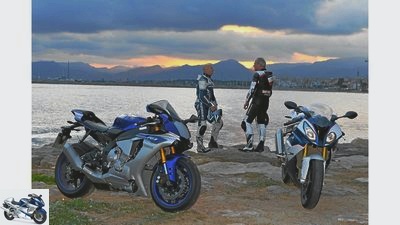
7/31
Despite declining sales: super sports cars remain the crowning glory of motorcycle creation.
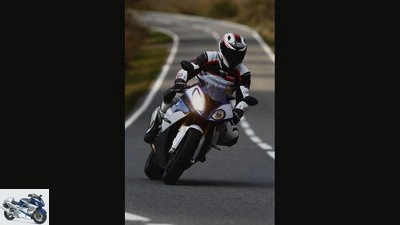
8/31
BMW S 1000 RR.
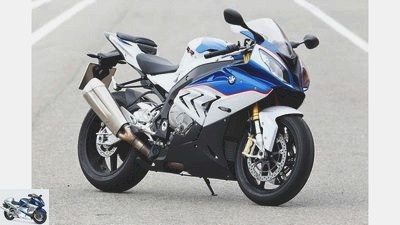
9/31
BMW S 1000 RR.
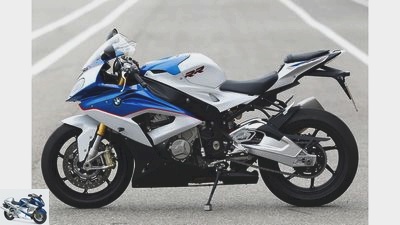
10/31
BMW S 1000 RR: Its engine and its suitability for everyday use are the great strengths of BMW.
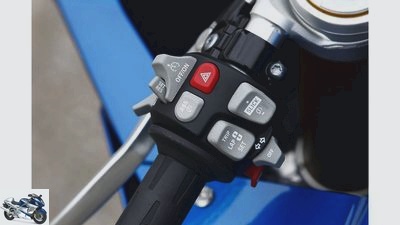
11/31
BMW S 1000 RR.
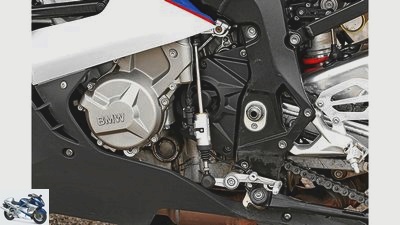
12/31
… As far as the function of the shift assistants is concerned, the BMW S 1000 RR is one step ahead – when shifting up and down.
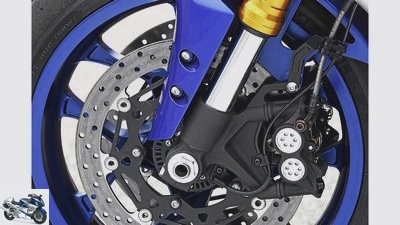
13/31
… a standard for super athletes, but one that allows for variations.
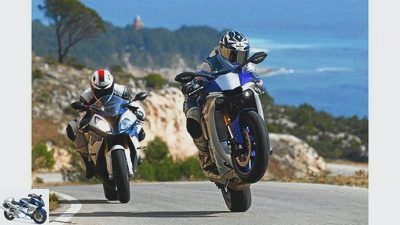
14/31
The new Yamaha YZF-R1 competes in a first comparison test against the established BMW S 1000 RR, which has been thoroughly revised for this year.

15/31
Head down, arms slightly bent: the Yamaha YZF-R1 steers with the precision of a circular stroke.
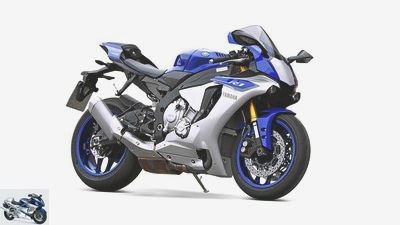
16/31
In addition to the similarities with the MotoGP-M1, the complexity of the exhaust system is evident here.
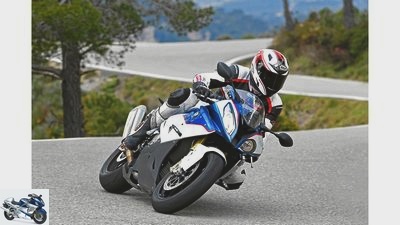
17/31
It sits more upright on the S 1000 than on the R1.
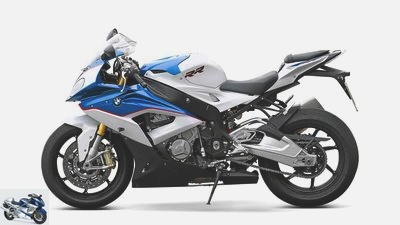
18/31
Air flow is an important issue. As the “body” of the S 1000 clearly shows.
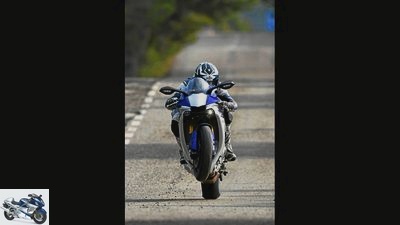
19/31
Yamaha YZF-R1: A touch of Tourist Trophy, more wheelie games included.
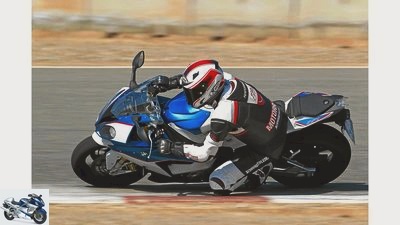
20/31
BMW S 1000 RR: Country roads, racetracks and back – today’s athletes can do anything.
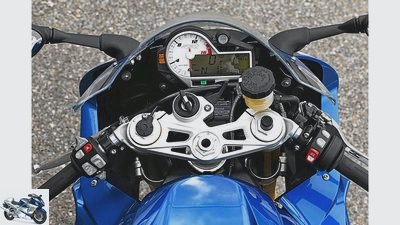
21/31
… than that of the S 1000, with the exception of the analog tachometer.
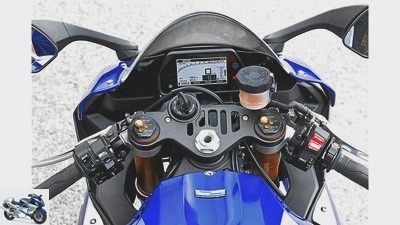
22/31
Openwork triple clamps are stingy with every gram. The display instrument of the R1 (here) is easier to read …
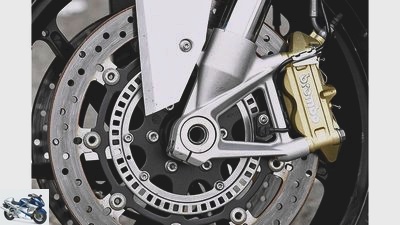
23/31
Brake calipers with one-piece body, radially screwed, sophisticated buttress at the fork base …
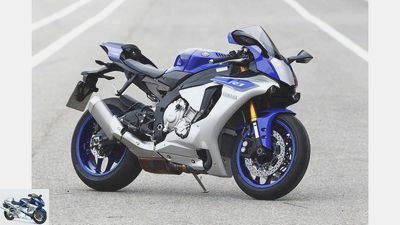
24/31
… the sovereign disregard of everyday concerns such as comfort or costs does the rest to bring the R1 to second place.
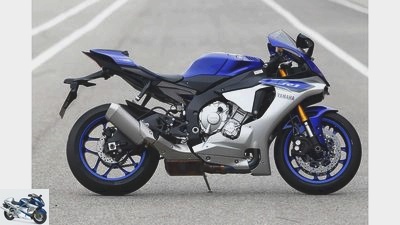
25/31
Yamaha YZF-R1: Torque weakness and rough response bring the R1 behind, …
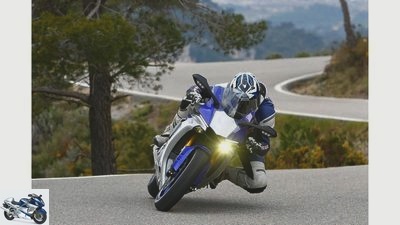
26/31
BMW S 1000 RR.
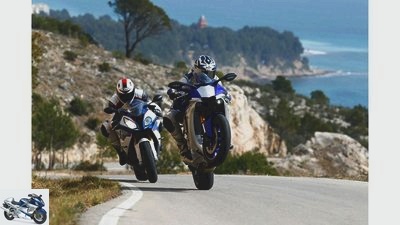
27/31
One can hope that the constant optimization of all super athletes will continue for a long time.
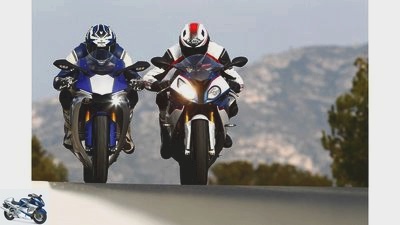
fact
28/31
When it comes to ABS, both manufacturers rely on different systems and philosophies.
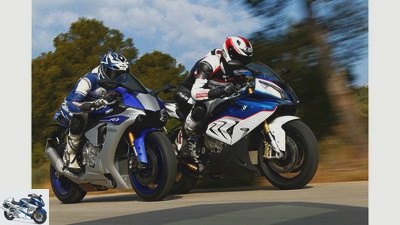
fact
29/31
Apart from the different characters of the two motorcycles, these and other subtleties confirm the degree of maturity of the BMW S 1000 RR.

30/31
BMW S 1000 RR.
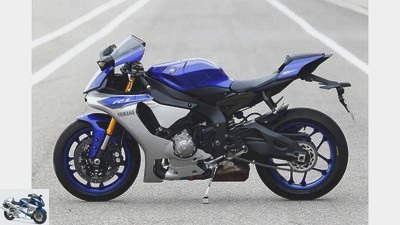
31/31
Yamaha YZF-R1.
BMW S 1000 RR and Yamaha YZF-R1 in comparison test
Duel of the super athletes
With more than 200 hp and less than 200 kilograms, it can happen that the front wheel snaps into the sky. The current reason for this array of dynamism: The new Yamaha YZF-R1 is competing in a first comparison test against the established BMW S 1000 RR, which has been thoroughly revised for this year.
The new Yamaha YZF-R1 was long awaited not only by Yamaha fans, but also by BMW. Since the last revision of the Kawasaki ZX-10R in 2011, the R1 has been the first super sports motorcycle from a major Japanese manufacturer, and one that has been developed from scratch. That created a lot of tension at BMW and gave rise to the BMW S. 1000 RR to be thoroughly revised in order to send it into the race against the new rival stronger than ever.
Buy complete article
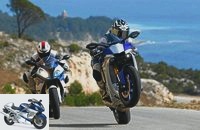
BMW S 1000 RR and Yamaha YZF-R1 in comparison test
Duel of the super athletes
Yamaha specifies the power of the Yamaha YZF-R1 with 200 hp, while the BMW figure for the BMW S 1000 RR with 199 hp remains below this limit. Are there understatement and diplomacy behind this, or does the small difference symbolize a bigger event, a change in the balance of power? In order to clarify this, the competitors had to reveal their performance before the test drives on the MOTORRAD test bench according to the tried and tested, comparability-creating procedure.
These motorcycles represent the crown of creation
The Yamaha YZF-R1 had to be the first to run, with 202 hp it exceeded the factory specification by two, the announced maximum torque of 115 Nm by three units. It was also 2700 rpm earlier than indicated. The reason for this deviation is to be found in the broad torque plateau that the R1 four-cylinder develops between 8500 and 12,200 rpm; here the torque is consistently over 110 Nm, and depending on the small motor and measurement tolerances, the maximum is either this or that speed. The testers were impressed. Then the BMW S 1000 R had the opportunity to add more. She did it. And how. Not only in the top performance, which soared to an exorbitant 208 hp. And not only in the peak torque, which reached 119 Nm, but also in the lower speed range between 4500 and 8000 rpm. Here the BMW put up to 10 HP and 20 Nm between itself and the Yamaha.
It went on on the street. Because the winter in Germany tenaciously defended its rule, MOTORRAD tested it in Spain, in the hinterland of the Costa Dorada, where the hilly topography, in combination with EU funding, created beautiful roads. Always curvy, sometimes narrow with tight radii, sometimes broad in wide curves, mostly perfectly paved. If not, they are criss-crossed by selective bumps. A paradise, also for super athletes. They are not allowed to develop their full power in public transport, but their sovereignty and precision, the high quality of their suspension elements and other components are always inspiring. For the author, the Yamaha YZF-R1 and the BMW S 1000 RR still represent the crown of creation. Even high-quality crossover models such as the Ducati Multistrada benefit from the technology that was first tested in athletes under extreme demands, speeds and loads.
Both motorcycles allow shifting lazy driving
The Yamaha YZF-R1 is completely imbued with the pursuit of driving dynamics. Even more than the BMW S 1000 RR, which every now and then allows its riders a little more everyday practicality. This was noticed after a short distance and the first motorcycle exchange based on the ergonomics of the two. On the BMW, the driver sits lower, with a comparatively narrow knee angle, but the handlebars are mounted quite high. On the Yamaha – comfortable for long-legged riders – the knees don’t have to be angled as much because of the high seat and the slightly lower footrests. The handlebar halves are placed low, just 2.5 centimeters higher than the seat – the information in the top test (issue 8/2015) erroneously moved them one centimeter higher. Either way, this arrangement requires a deep stooped posture, and that acts as a constant call to committed (high) driving. You like to follow it whenever possible, the day is young and you don’t feel old yourself. But in the forced strolling traffic or in the burgeoning exhaustion after a long day of driving, one is more drawn to the BMW.
Further insights into the character of the two motorcycles: Both allow shifting lazy driving, the BMW S 1000 RR however two gears higher. On the Yamaha YZF-R1, because of the low torque in the middle and the relatively long overall ratio, the driver gets the impression of staying better in the lower three gears. A feeling that the torque values confirm. They are determined with the throttle fully opened in the highest gear and represent the extreme demand for strong acceleration from the lower speed range. But although in practice the last gear is rarely accelerated stubbornly, so the differences are not quite as evident, they reflect the relationships correctly. The subtle pulsating V4 sound of the crossplane in-line engine also tempts you to drive it at higher speeds than a normal in-line engine.
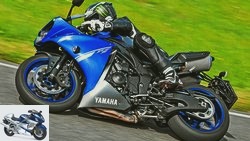
Super athlete
Zonko’s attack on the Yamaha YZF-R1
Too fat for this world
read more
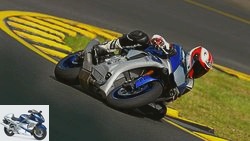
Super athlete
Yamaha YZF-R1 in the driving report
The Empire Strikes Back
read more
All tests and articles about the Yamaha YZF-R1
BMW developers have deliberately avoided using a balancer shaft
The differences in acceleration are less significant than the pull-through values. In the area of 200 hp, a slight increase in peak power hardly brings more propulsion: up to 200 km / h, the BMW S 1000 RR gains a full three tenths of a second, and an experienced rider has to do this with the usual clutch and throttle grip despite the race start assistant and wheelie control realize. Far more important for everyday life and the race track than sheer acceleration is the engine’s responsiveness. A comparison of the two machines in different modes shows that the direct or, if you will, harder of two variants of the BMW still responds more gently than the gentlest of three variants of the Yamaha YZF-R1, which also has a reduction in torque goes hand in hand.
So if you want to use the full traction of the Yamaha YZF-R1, you have to tap the gas with great feeling if you don’t want to provoke a hard load change despite the impeccable mechanics of the drive train. This is particularly annoying on unknown routes, where you have to play with the gas more often. In return, the new R1 engine spoils with almost perfect running culture. The four-cylinder with crossplane crankshaft fires at uneven intervals, but vibrates less and more gently than the BMW four-cylinder with conventional firing order. The balance shaft, which the Yamaha engineers consider indispensable due to the special engine configuration, does a very good job. The BMW developers have deliberately omitted a balancer shaft in order to minimize internal performance losses. In view of this, the smoothness of the BMW S 1000 RR is again remarkable.
In terms of sound, the Yamaha YZF-R1 holds back too much. Thanks to the unusual firing order, it sounds deeper than the BMW S 1000 RR anyway, and its rhythm should be heard louder. But the Yamaha exhaust damps more than the new BMW system, which does not have a front silencer. This has a hoarse timbre and develops a provocative roar at high speeds. When the throttle is closed, the fuel supply is not immediately interrupted; a few tiny, deliberately injected fuel droplets ensure a rich exhaust murmur that spreads a touch of Formula 1 in the braking zone. It never gets annoyingly loud. But the BMW sounds as if it were an aggressive beast, the Yamaha, on the other hand, fakes the satisfied, full growling bears.
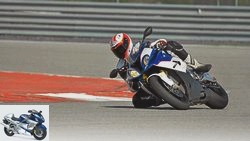
Super athlete
BMW S 1000 RR in the driving report
Heavily revised Bayern Express
read more
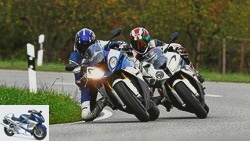
Super athlete
BMW S 1000 RR old versus new in the test
All things new. But also better?
read more
A symbolic photo: There‘s Zug behind it.
What sounds like wasted gasoline is hardly noticeable in terms of consumption. Ridden by the same testers on the same route at the same speed and constantly changing, the BMW S 1000 RR needed 0.4 liters less than the Yamaha YZF-R1 per 100 kilometers. Because it also has a little more tank volume, it can do almost 30 kilometers more than its competitor on one tank of fuel. These results show how well-engineered the S 1000 RR is now, because only through diligent detailed work can an engine achieve more peak power and a fuller torque curve at the same time, and all of this with even lower fuel consumption. The high level of maturity of BMW technology is also evident in details such as the gearshift assistant, which is no longer just a racetrack gimmick. The Shift Assistant Pro with smooth gear changes pleases up and down. If you ever tormented the gearbox while downshifting, the throttle valves were still a little open. If you consistently close the gas and don’t use the clutch, you simply need to step through the gears, the electronics do the rest. Right up to precisely metered throttle pulses when shifting down to first gear in order to moderate the engine’s drag torque.
On the Yamaha YZF-R1, the shift assistant only works when upshifting. Its function can be set in two stages, but even in the stage with the longer shift times, smooth gear changes are not always possible in everyday traffic. However, the system works perfectly at full acceleration on the motorway or racetrack.
Ratio comparable to that of Honda and Yamaha in the MotoGP World Championship
In terms of engine and drive, the relationship between the BMW S 1000 RR and the Yamaha YZF-R1 is comparable to that of Honda and Yamaha in the MotoGP World Championship. A few horsepower less have rarely stopped the YZR-M1 from winning races. Even in the duels against the seemingly overpowering duo Marc Márquez and Honda RC 213 V, the excess speed that the Yamahas allow in the first phase of cornering has often been observed. And the R1, which is bringing many of its layouts back to the M1, feels like it could do the same – taking a hard-to-believe pace through the corners. The reason for this lies in their sensationally safe front wheel guidance, their precision in steering behavior and feedback.
The BMW S 1000 RR has more comfortable suspension and damping, which benefits its riders on country roads. A few test laps on the Alcarràs racetrack showed that the more comfortable set-up of its suspension elements takes some getting used to. The spring movements at the front gave the testers the feeling that they weren’t exactly hitting the line, and the hindquarters started pumping when accelerating hard. Over time, concerns about steering precision turned out to be unfounded, and the rear suspension behaved even better with reduced compression than with a tight setting, but on the track the Yamaha YZF-R1 made it easier with its tight set-up. Letting it run into a fast curve over a series of waves, feeling how the front tire meshes with the asphalt, the suspension working, and seeing how exactly you hit the line is an exquisite experience. You are happy to do the required physical effort.
BMW S 1000 RR factory-set with four preconfigured modes
The BMW test machine was equipped with semi-active damping, the individual functions of which, deviating from the factory setting, can be varied in 15 steps. The adjustment range could extend even further in the direction of tight in some functions, at least in the rear rebound. However, this is only to be regarded as a preliminary test statement, because the race track was not the focus of the comparison test between the BMW S 1000 RR and the Yamaha YZF-R1. A large racetrack comparison of all current super sports cars in mid-May will provide more precise information.
At Yamaha, the semi-active damping of the YZF-R1 M is reserved, but this noble R1 is already sold out in Germany. Off the racetrack, the BMW S 1000 RR did not leave any need for individual suspension settings – on the racetrack, by the way, not even with every tester. The set-ups, which come with the four pre-configured modes Rain, Sport, Race and Slick, were ideal for drivers of different stature. For the country road, most were very satisfied with the Sport mode. If you prefer something more spectacular, you can also activate the Race mode.
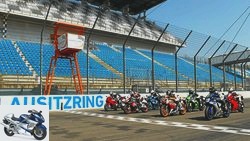
Super athlete
Seven super athletes in the track test
Part 1 comparison test on the racetrack
read more
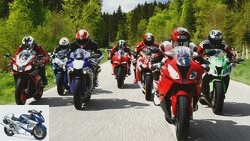
Super athlete
Seven sports motorcycles in the country roads classification
Part 2 comparison test on the country road
read more
The ABS and combination brake system of the Yamaha YZF-R1 are constantly activated
During the test drives on the Yamaha YZF-R1, there was a clear tendency towards softer pressure damping. At the fork it was open 23 of 29 clicks, at the rear in the high-speed setting it was 5.75 out of a total of six revolutions. The preload of fork and shock absorber has also been slightly reduced compared to the standard setting. The modules of the YRC (Yamaha Ride Control) were mostly on two for the motor control (PWR), the nine-stage adjustable traction control (TCS) for the racetrack on two, for the country road on three. Level four doesn’t hurt here either. As far as the other modules are concerned, the factory settings are good for you. Or to put it briefly: the B-mode with the TCS set to level three covers a wide range from sporty country roads to serious racing. When it comes to ABS, both manufacturers rely on different systems and philosophies. The ABS and the combination brake system of the Yamaha YZF-R1 are constantly activated. It is up to the system whether the rear brakes are applied to different degrees in different modes. The driver does not find out about this.
With the BMW S 1000 RR, the rear brake function and ABS control on the rear wheel decrease the more it is trimmed for use on the racetrack. The ABS can even be switched off completely. With the same average delay, the S 1000 could be dosed better; their brakes also changed less than the R1 system under high loads. Apart from the different characters of the two motorcycles, these and other subtleties confirm the maturity of the BMW. You can tell that it has been modeled in the third generation. If you extrapolate your progress to the Yamaha YZF-R1, which is at the beginning of its development, you can look forward to an exciting future. And hope that the constant optimization of all super athletes will continue for a long time.
Technical specifications
Despite declining sales: super sports cars remain the crowning glory of motorcycle creation.
MOTORCYCLE test results
Many roads in the Spanish hinterland offer non-slip asphalt.
1. BMW S 1000 RR
Its engine and its suitability for everyday use are the great strengths of the BMW S 1000 RR. That doesn’t mean that she doesn’t have anything to order against the Yamaha on the racetrack. But the transition to radical fast driving is not as easy on it as on the Yamaha YZF-R1.
2. Yamaha YZF-R1
Torque weakness and gruff response bring the Yamaha YZF-R1 behind, the sovereign disregard of everyday concerns such as comfort or costs does the rest to bring the R1 to second place. In spite of this, or perhaps because of it: a fascinating motorcycle.
Related articles
-
fact 27 pictures fact 1/27 After six years, Yamaha has completely redesigned the sporty top model. The new YZF-R1 now has a completely …
-
Comparison test of the 1000 super sports car
Jaime de Diego 38 pictures fact 1/38 Yamaha demands 14895 euros for their completely new R1 super sports car. fact 2/38 Even without ABS, the Fireblade would …
-
Comparison test BMW S 1000 RR, Ducati 1299 Panigale S and Yamaha YZF-R1
fact 46 pictures fact 1/46 Yamaha YZF-R1. fact 2/46 BMW S 1000 RR. fact 3/46 The swing arm takes the wheel axle very far back – good for the …
-
Comparison test BMW S 1000 R and BMW S 1000 RR
www. 26 pictures www. 1/26 Regicide has always started mostly from the family. History can repeat itself …
-
Suzuki V-Strom 650 and Suzuki V-Strom 1000 in comparison test
fact 8th photos fact 1/8 With a torque plateau already starting at 3500 rpm, the test bench also demonstrates the punch of the Suzuki V-Strom 1000 in the…
-
fact 34 photos fact 1/34 For the 11/2015 issue of MOTORRAD, the Supersport septet rode the “Masterbike 2015” at the great Lausitzring in Brandenburg….
-
Comparison test Suzuki B-King, Yamaha MT-01 and Triumph Rocket III
fact 15 pictures artist 1/15 artist 2/15 artist 3/15 artist 4/15 artist 5/15 artist 6/15 artist 7/15 artist 8/15 artist 9/15 artist 10/15 artist …
-
Comparison test of sports enduro bikes KTM 450 EXC and Yamaha WR 450 F
markus-jahn.com 23 pictures markus-jahn.com 1/23 Yamaha flies with the WR 450 an attack on the high-flyer 450 EXC from KTM. markus-jahn.com 2/23 KTM …
-
Comparison test Kawasaki Z 900, MV Agusta Brutale 800 RR Yamaha MT-09 SP
fact / Joachim Schahl 21 pictures fact / Joachim Schahl 1/21 Kawasaki Z 900, MV Agusta Brutale 800 RR and Yamaha MT-09 SP promise undisguised driving pleasure …
-
Honda VTR 1000 test V-Lenz Spring is all about the new two-cylinder. In the spotlight: Honda’s VTR 1000 F. You didn’t like to read it, those responsible…